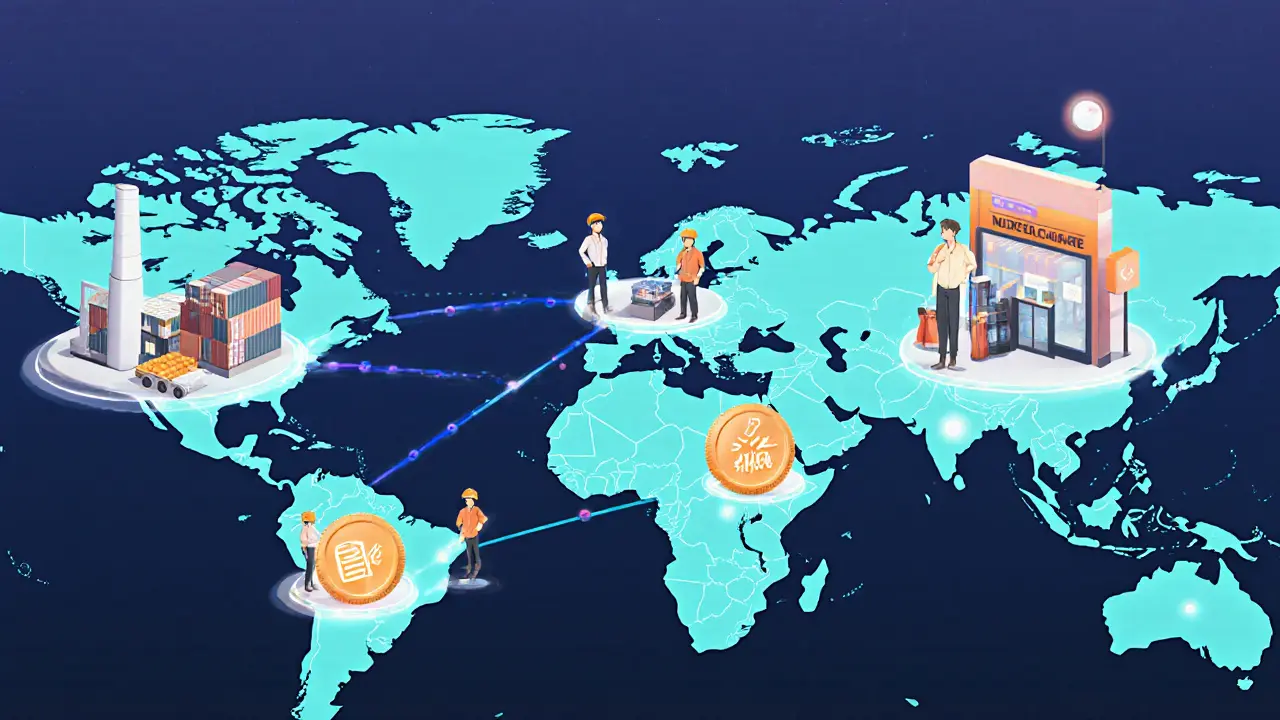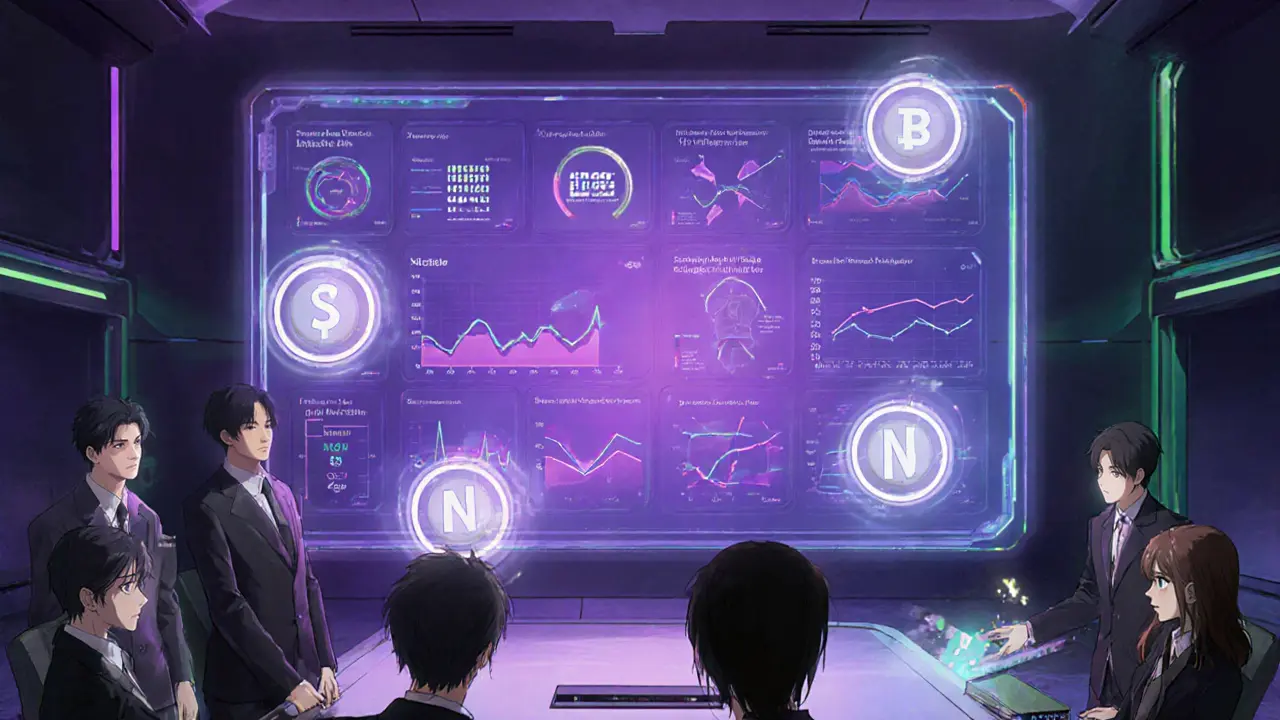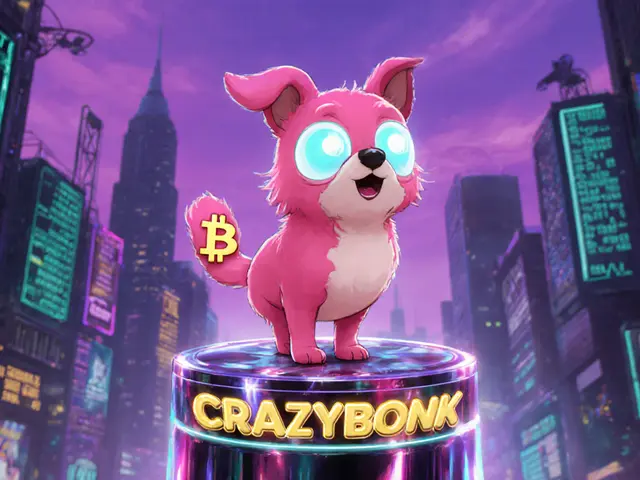NFT Supply Chain Benefits Calculator
Estimated Benefits
Annual Fraud Savings
$0
Reduction in counterfeit losses
Settlement Time Reduction
0
Days saved per transaction
ROI Projection
With NFT implementation, you can expect to see a return on investment in approximately years.
This projection assumes a reduction in fraud losses and improvement in operational efficiency.
Quick Takeaways
- NFTs create a tamper‑proof digital identity for every physical item.
- Counterfeit losses can drop dramatically because authenticity is instantly verifiable.
- End‑to‑end traceability lets managers spot bottlenecks before they become costly delays.
- Digital product passports embed sustainability data, helping firms meet new EU regulations.
- Smart contracts tied to NFTs automate payments and speed up trade finance.
What an NFT is: a unique, blockchain‑backed token that can represent ownership, provenance, or any data linked to a specific asset means for a physical product
Imagine a sneaker, a pharmaceutical batch, or a high‑value electronic component each carrying its own digital certificate. That certificate lives on a distributed ledger, never changes, and can be read by anyone with permission. When you scan a QR code on the box, the system pulls the associated token and shows you the full history - from raw material origin to the moment it leaves the retailer’s shelf.
Unlike generic barcodes, which only point to a database that can be edited, the token’s hash is immutable. This immutability is the foundation for all the benefits we’ll explore.
NFTs are not just art collectibles; they are data containers that travel with real‑world goods.
Stopping Counterfeits in Their Tracks
Global counterfeit sales exceed $400billion per year, according to OECD estimates. The damage ripples through brand reputation, safety, and tax revenue. By assigning a unique token to each item, manufacturers give buyers a one‑click verification method. Scanning the code pulls the token’s provenance, instantly confirming whether the product matches the genuine manufacturer’s record.
Because the token can’t be altered, counterfeiters can’t forge the digital certificate. Even if they copy the packaging, the missing or mismatched token reveals the fraud within seconds.
End‑to‑End Traceability and Provenance
Traditional ERP systems often rely on spreadsheets or siloed databases, making it hard to piece together a product’s full journey. An IPFS decentralized file storage that links large data sets to blockchain hashes stores detailed documents - certificates, test results, shipping manifests - as immutable files. Their hash is then anchored to the NFT.
When a raw‑material batch enters a factory, a new token is minted. As the item moves through manufacturing, each process (e.g., welding, coating) adds a signed event to the token’s metadata. Logistics providers append location stamps, and retailers record shelf placement. The result is a chronological, auditable trail that can be queried in real time.
Supply chain managers use this view to pinpoint exactly where a delay occurred, reroute shipments, or isolate a defective lot for recall.
Boosting Transparency Across Stakeholders
Transparency has been a buzzword for years, but Supply Chain Management the coordinated planning and execution of product flow from suppliers to customers still suffers from data islands. NFTs act as a shared ledger that every authorized party can read without needing a central middleman.
Third‑party logistics firms, distributors, and even end consumers gain a single source of truth. When a retailer sees that a shipment arrived on time and met all quality checks, they can release payment instantly via a smart contract, eliminating days of paperwork.
Digital Product Passports & Sustainability Goals
The European Union’s new “digital product passport” rule requires sectors like textiles, batteries, and electronics to disclose material composition, carbon footprint, and end‑of‑life handling. Embedding that information in an NFT creates a portable passport that travels with the item.
For example, a solar panel’s token can list the percentage of recycled aluminum, the factory’s CO₂ emissions, and instructions for safe recycling. Regulators can query the token to verify compliance, and eco‑conscious consumers can see the exact impact before purchase.

Automated Payments and Trade Finance
When the token records that a container has cleared customs and arrived at the destination port, a pre‑programmed smart contract releases the invoice amount to the supplier. This instant settlement cuts financing cycles from weeks to minutes.
Bankers can also use the token’s status as collateral. A manufacturer needing working capital can obtain a short‑term loan based on the verified location and condition of goods, reducing reliance on costly letters of credit.
Quality Assurance, Recalls, and Compliance
Every inspection - from visual checks to lab analyses - writes a signed entry to the NFT. If a defect is discovered, the system can instantly trace all downstream units that share the same batch identifier, enabling targeted recalls instead of costly blanket pulls.
Regulatory audits become simpler because auditors can pull the full audit trail directly from the ledger, eliminating the need for physical paperwork.
Data Analytics, Business Intelligence, and Continuous Improvement
Because each product carries granular data, analysts can run cohort analyses on a per‑item basis. Patterns emerge: a particular supplier’s raw material consistently leads to a 2% delay, or a shipping route through Port X has a higher damage rate.
These insights feed back into supplier selection, route optimization, and inventory forecasting, turning the supply chain from a reactive system into a predictive engine.
Secondary‑Market Value and Circular Economy
When a used laptop is sold on a resale platform, the buyer can scan the token to verify original specs, warranty status, and service history. That transparency often commands a premium price and reduces disputes.
Manufacturers can also program royalty payments into the token, earning a small fee every time the product changes hands - a new revenue stream for circular‑economy business models.
Comparison: Traditional Tracking vs. NFT‑Based Tracking
| Aspect | Traditional Systems | NFT‑Based Systems |
|---|---|---|
| Data Integrity | Editable databases; risk of tampering. | Immutable blockchain hashes; cannot be altered. |
| Visibility | Limited to internal stakeholders. | Permissioned real‑time access for all parties. |
| Counterfeit Detection | Reliant on manual checks or barcodes. | One‑click verification via token provenance. |
| Payment Settlement | Invoice‑based, days to weeks. | Smart‑contract automation; near‑instant. |
| Regulatory Reporting | Paper‑heavy, prone to errors. | Digital passport embedded in token; audit‑ready. |
| Scalability | Challenged by data silos. | Designed for billions of tokens with low marginal cost. |
Implementation Considerations
Adopting NFTs isn’t a plug‑and‑play upgrade. Companies need to address three practical fronts:
- Technical Integration: Existing ERP and WMS platforms must be able to read/write blockchain hashes. Middleware or API gateways often bridge legacy systems with public or permissioned ledgers.
- Standards and Interoperability: Industry consortia are working on common NFT schemas (e.g., GS1 Digital Link, EPCIS). Aligning with these standards avoids vendor lock‑in.
- Cost vs. ROI: Initial blockchain infrastructure, staff training, and token‑minting fees add up. Studies show a potential reduction of 2‑5% in operational costs and up to 30% fewer counterfeit incidents - a pay‑back period of 2‑3years for large manufacturers.
Pilot programs in pharmaceuticals and high‑value electronics have already demonstrated measurable gains, giving confidence for broader roll‑outs across consumer goods.
Next Steps for Decision‑Makers
- Map your most critical products - those with high fraud risk or regulatory exposure.
- Choose a blockchain platform that balances speed, cost, and governance (e.g., permissioned Hyperledger vs. public Polygon).
- Design the data model: decide which events (material origin, quality checks, transport milestones) will be recorded on‑chain.
- Run a limited pilot with a single SKU, measure counterfeit detection rates and settlement times.
- Scale gradually, adding suppliers and logistics partners as the ecosystem matures.

Frequently Asked Questions
Can NFTs be used for low‑value items?
Yes. The cost of minting an NFT can be as low as a few cents on high‑throughput, low‑fee blockchains. For mass‑produced goods, bulk minting and batch tokenization keep expenses minimal while still delivering traceability.
How does privacy work when many parties can read the token?
Permissioned blockchains allow role‑based access. Sensitive data (e.g., pricing) can stay off‑chain, with only a hash stored on the NFT. Authorized parties decrypt the off‑chain data through secure APIs.
What standards should I follow for NFT metadata?
The GS1 Digital Link specification and the EPCIS 2.0 standard are gaining traction. They define fields for product identifiers, timestamps, and location data that map cleanly to blockchain metadata.
Will using NFTs increase my carbon footprint?
Modern proof‑of‑stake or permissioned networks consume far less energy than early proof‑of‑work blockchains. Many enterprises offset remaining emissions through renewable‑energy credits, keeping the overall footprint low.
How quickly can I see a ROI?
Companies that target high‑risk, regulated products often realize cost savings within 12‑18 months, mainly from reduced fraud, faster settlements, and lower audit expenses.












Charles Banks Jr.
May 29, 2025 AT 12:13 PMOh great, another buzzword trying to fix supply chains. Because slapping a shiny token on a box magically stops fraud, right? 🙄
Michael Wilkinson
May 29, 2025 AT 12:46 PMListen up: if you think NFTs will solve every logistics headache without solid process overhaul, you’re dreaming. Real change demands data integrity, not just flashy collectibles.
Kate Roberge
May 29, 2025 AT 13:20 PMHonestly, the whole “NFT supply‑chain” hype feels like a corporate PR stunt. Most companies will just toss a token on a pallet and call it innovation, while the underlying issues stay untouched.
MD Razu
May 29, 2025 AT 14:26 PMWhen we speak of NFTs in the context of supply chain management, we must first interrogate the ontology of trust that underpins our logistical networks. Trust, historically, has been instantiated through contracts, reputation, and physical verification; the digital token merely shifts the locus of verification to a distributed ledger. Proponents argue that this shift eliminates the need for intermediaries, yet the ledger itself becomes a new form of intermediary, demanding its own governance and security protocols. Moreover, the immutability of blockchain records, celebrated as an advantage, introduces rigidity that can be at odds with the fluid nature of real‑world commerce where exceptions and manual overrides are commonplace.
The purported reduction in settlement time, often quoted in glossy white papers, assumes that every participant possesses the requisite infrastructure to read and write to the chain instantly, an assumption that neglects the latency introduced by network congestion and the cost of gas fees. In practice, this can translate to delayed payments rather than accelerated ones, especially for smaller suppliers lacking capital reserves.
From an economic standpoint, the ROI models presented tend to abstract away the hidden costs of token creation, wallet management, and staff training; these expenses can erode the projected savings from fraud mitigation. Speaking of fraud, while NFTs can embed provenance data, they do not inherently prevent the physical tampering or counterfeiting of goods, which remains a material threat in many industries.
Philosophically, we must ask whether tokenizing an asset merely reifies ownership in a way that obscures the underlying labor and environmental costs associated with production. If the ledger records a product’s journey without reflecting the carbon footprint of each transport leg, we risk presenting an illusion of transparency while ignoring critical sustainability metrics.
Finally, the sociotechnical dimension cannot be ignored. Introducing token‑based systems reshapes power dynamics, potentially disenfranchising actors who are unable or unwilling to adapt to blockchain technologies. In conclusion, while NFTs offer intriguing possibilities for data integrity, they are not a panacea; their integration must be accompanied by holistic process redesign, rigorous cost‑benefit analysis, and an awareness of the broader ethical implications.
Without a clear governance framework, disputes over token provenance could devolve into costly legal battles. Stakeholders must also consider the environmental impact of the underlying consensus mechanisms, which, in many public blockchains, remain energy intensive. Therefore, any decision to adopt NFTs should be predicated on a thorough assessment of technology maturity and alignment with strategic objectives. Otherwise, organizations risk investing in a veneer of innovation that delivers little substantive value.
april harper
May 29, 2025 AT 15:00 PMAnother tech fad, another empty promise.
Carl Robertson
May 29, 2025 AT 15:33 PMWatching the NFT hype cascade over supply chains feels like watching a soap opera where every character believes they're the hero. The drama is palpable, with executives chanting “blockchain!” as if it were a magical incantation. Yet the plot twists reveal that the underlying data integrity issues remain unresolved, and the supposed villains-fraudulent actors-still find loopholes. In the end, the audience is left with a cliffhanger: will the next version of the token finally deliver, or will it crumble like so many previous tech promises?
Rajini N
May 29, 2025 AT 16:06 PMIf you’re considering an NFT layer for your logistics, start by mapping out the exact data points you need immutable proof for-batch IDs, timestamps, and origin certificates are common. Then evaluate whether a permissioned blockchain meets your latency and cost requirements better than a public one. Remember to train staff on wallet security and establish clear SOPs for token issuance. Finally, pilot the system on a single product line before scaling, so you can iron out integration bugs without disrupting the whole supply chain.
Jason Brittin
May 29, 2025 AT 16:56 PMLooks like NFTs are finally getting a seat at the logistics table-finally, something exciting for the supply chain nerds! 🚀 If it actually cuts down paperwork, I’m all for it; if not, at least we got a cool new buzzword to brag about. 😂
Lindsay Miller
May 29, 2025 AT 17:30 PMIt’s easy to feel overwhelmed by all the tech talk, but at the heart of it, NFTs could help people trust what they buy, especially in places where counterfeit goods hurt local artisans.
Waynne Kilian
May 29, 2025 AT 18:20 PMmaybe nft tech can bring peopel together by making supply chain more transparent, but we gotta keep an open mind and not jump too fast into it.